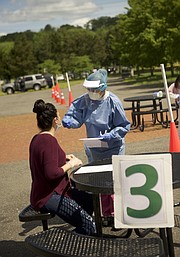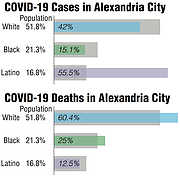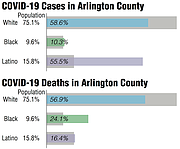Arlington drive-through coronavirus sample testing site on Quincy Street. By appointment only, between 9 a.m.-3 p.m. Photo by Shirley Ruhe.
The population of Fairfax County is 16.8 percent Hispanic, but Latinx individuals account for 65.3 percent of positive COVID-19 cases in Fairfax County.
By Sunday, June 14, months into the pandemic, African Americans accounted for 1,154 deaths, more than 41 percent of the total, in Maryland even though they account for 30.9 percent of the overall population.
Arlington’s Latinx community makes up 15.8 percent of the county’s population, but accounts for 55.5 percent of the positive COVID cases. And Arlington’s black population which makes up about 1 in 10 people (9.6 percent) in the county accounts for almost 1 in 4 deaths (24.1 percent).
In Alexandria, Latinx population, which comprises 16.8 percent of the City, has had 55.5 percent of Alexandria’s positive cases.
Montgomery County’s black population had the highest rate per 100,000 individuals (79). And the African-American population in Montgomery County was the only demographic that had a greater percentage of deaths than its demographic predicts.
THE NORTHERN VIRGINIA Regional Commission concluded that Latinos accounted for a disproportionate number of coronavirus cases in this area.
“The HIspanic or Latino share of cases in Northern Virginia is three-and-a-half times their overall share. All health districts in NOVA have significantly higher shares [for the Latino population]. This indicates significant ethnic disparities in COVID 19 cases.”
Coronavirus cases by zip code in Northern Virginia also revealed disparities by race, ethnicity and economic status. In the City of Alexandria, zip code 22305 stood out for 579 cases.
“Although viruses do not discriminate, the COVID-19 virus disproportionately impacts vulnerable populations just as other diseases and health conditions do,” according to the Alexandria City Government, explaining some disparities.
The zip codes with higher concentrations of poverty, lower education levels, and crowded housing conditions tend to have the highest rates of COVID. These people are more likely to work in jobs where they are underpaid, don’t get paid sick leave, depend on public transit and don’t have telework opportunities, bringing more risk of exposure to coronavirus.
“Inequitable conditions have created disproportionate rates of chronic health issues resulting in large differences in life expectancy across Alexandria. Now, these chronic health issues also make people more susceptible to severe disease from COVID-19 infection,” the city report said.
“AFFLUENCE in Northern Virginia masks gaps in health and economic opportunity that have been exacerbated even further by the current coronavirus pandemic,” according to the Northern Virginia Health Foundation.
“Although everyone is potentially susceptible to the virus, research shows that people of color and low-income families are especially vulnerable and have higher death rates from COVID-19,” said Steven H. Woolf, of Virginia Commonwealth University and the Northern Virginia Health Foundation. “They have greater exposure to the virus, are more susceptible to complications, have greater barriers to health care, are more vulnerable economically, and suffer from deteriorating health caused by deepening economic adversity.”
Northern Virginia is a “seemingly affluent area” with good health statistics in general, but life expectancy varies by 17 years within the region, he said. “Economically marginalized communities will face devastating wage losses, unemployment and food scarcity. Low income families will undoubtedly struggle the most to rebound.”
THE PANDEMIC has magnified discrepancies that health officials already knew were there.
According to the Arlington County Government, “Arlington rightfully celebrates being highly ranked in many areas, like employment, education and health. However, looking beyond aggregate data and drilling into results in different geographic, ethnic, racial and other often-marginalized groups reveals that health disparities exist among Arlingtonians in these groups. Not everyone is thriving.”
According to the Fairfax County health department, “The data does underscore some of the existing disparities in Fairfax which make certain populations more susceptible to exposure and to greater risks from COVID-19 infection, just as they are for other diseases and health conditions.”
“Simultaneously, COVID-19 continues to showcase and exacerbate the disparities that exist in our most vulnerable communities,” said Fairfax County Chairman Jeff McKay.
“Now more than ever, we know it is the role of our local government to achieve true structural change in our communities. We in Fairfax County must honestly ask ourselves, ‘What actions are we taking?; What voices are we lifting up?;’ and for me as your Chairman, ‘Are our policies affecting systemic change in our community?’”




